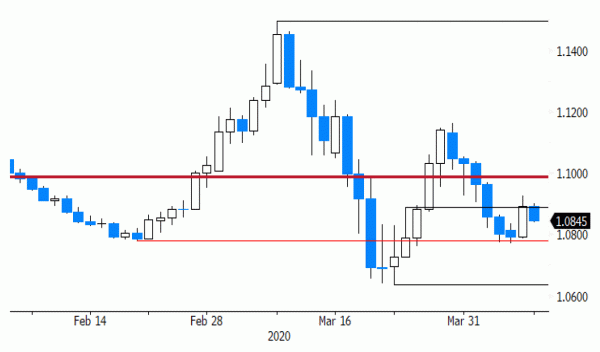- Rates: Risk rebound shows fragility
This week’s risk rebound ran out of steam during yesterday’s US trading session. Core bonds lost ground, but ended off their intraday weakest levels. Eurogroup finance ministers haven’t concluded their conference on EMU fiscal aid for the corona crisis yet. Discussions might last into the weekend and show the highly divided EMU. - Currencies: EU indecisiveness does help the euro
Yesterday, a continuation of the risk rebound caused broad US correction and supported smaller, less liquid currencies. EUR/USD also rebounded. The overall USD trend will remain the key driver for EUR/USD trading. Even so, the difficult process to reach a coordinated financial response at an EU level doesn’t call for any euro outperformance in the short-term
The Sunrise Headlines
- US equities lost steam and slipped into negative territory as investors continued to weigh new coronavirus developments. The Nasdaq (-0.33%) underperformed. Asian markets trade mixed with Japan a standout outperformer (2.63%).
- US president Trump threatened to halt funding to the WHO, accusing the global health agency of being “very China centric” and criticizing it of failing to catch the coronavirus pandemic early enough.
- S&P lowered its outlook on Australia’s coveted AAA rating to negative from stable in anticipation of a material weakening in the government’s debt position as it splashes out a large fiscal stimulus package to fight the coronacrisis.
- Saudi Arabia called an extraordinary meeting with G20 energy ministers on Friday in a bid to foster global dialogue and cooperation to stabilize energy markets during the coronacrisis and enable a stronger global economy.
- The Trump administrations seeks an extra $250bn to replenish the $350bn small business payroll program that took off last week but was quickly overrun as companies jumped at the chance to tap up to $10mln in forgivable loans.
- The ECB announced it is temporarily easing collateral rules to boost bank lending during the coronacrisis and also granting a waiver to accept junk-rated Greek government bonds as collateral to ease the country’s access to liquidity.
- In today’s economic calendar investors eye the EU’s (lack of?) coordinated response to tackle the coronacrisis. The Polish CB is announcing its rate decision and FOMC minutes are due. Germany, the UK and the US tap the bond market.
Currencies: EU Indecisiveness Does Help The Euro
Monday’s risk rally initially continued yesterday and global FX traded accordingly. Smaller currencies ranging from the CE currencies to the Aussie dollar profited from the relief and from an easing USD bid. The euro also succeded a nice countermove as markets awaited the result of the EU finance ministers’ meeting. Still, the dollar decline slowed later as US stocks couldn’t hold on to initial gains. US yields also reversed an initial rise, but for now this is no decisive factor for the USD. EUR/USD closed at 1.0892.The TW USD (DXY) still closed just below the 100 mark. USD/JPY is still facing conflicting drivers (global USD move vs risk sentiment) and closed modestly lower at 108.76.
This morning, risk sentiment in Asia is cautious, but still can be labelled constructive given the price moves on WS. Some countries (Japan, Singapore) are still taking additional steps to contain the corona virus. The dollar is gaining modest ground. USD/JPY is trading in the 108.90 area. The TW dollar (DXY) also gains a few ticks (110.15 area). The AUD declines (AUD/USD 0.6140 area) after S&P cut the outlook on the country’s rating, but the damage could have been worse.
Today, the eco calendar stays thin. Global risk sentiment remains the key driver for FX trading. Yesterday’s price action was a cautious sign that the run on the dollar is easing, but we’re probably not at the point yet where investors feel comfortable to scale back USD reserves. The difficult process to reach a coordinated financial answer on an EU level doesn’t’ help the euro ST. Even so, the USD trend, rather than EU specific news, probably will be the main driver for EUR/USD trading. Last week, EUR/USD falling below 1.09 deteriorated the technical picture. The pair tested 1.0775/70 support, but no clear break occurred. The March low comes in at 1.0636. We continue to watch the TW USD. The USD might stay well bid, but we see no compelling reason for a break beyond the 103 area. EUR/USD rebounding above the 1.0950 area would be a first indication that downside pressure is easing.
Yesterday, the EUR/GBP cross rate succeded a rather calm sideways trading session. Sterling didn’t profit further even as most smaller currencies outperformed. This suggests that sterling reached some ST equilibrium level after recent rebound. Some further consolidation in the 0.8750/0.90 area might be on the cards.
EUR/USD: 1.0770/75 support area holds, for now. Failure to reach an EU financing deal doesn’t help the euro
















